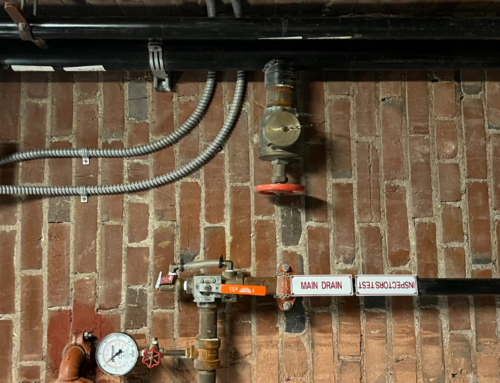Cutting Through The Noise On Wall Construction
For multi-unit living spaces, hospitals, and offices, privacy has become a significant issue.

As a side issue, the issuing of the American National Standards Institute [ANSI] S12.60, Acoustical Performance Criteria, Design Requirements and Guidelines for Schools, has made privacy between classrooms an issue of concern. Architects and designers only have sound transmission class (STC) ratings to guide them when selecting acoustical insulation for walls. Very little distinction is made between STC, apparent sound transmission class (ASTC), and noise isolation class (NIC) (STC is a laboratory test to measure the transmission of sounds through a sample of a basic wall construction with no electrical boxes or other ‘violations’ of the structure. Field sound transmission class (FSTC) is an in-situ test identical—in most respects—to STC except it is assessing a wall in the real world. Both STC and FSTC are reduced to per square foot and corrected for acoustical absorption in the receiving [listener’s] room. NIC is similar to FSTC except no correction is made for wall area or absorption in the receiving room. NIC is a ‘what you hear is what you get,’ to paraphrase a famous comedian. All of these tests are detailed in ASTM procedures). Even with the best construction practices, ASTC and NIC can be significantly lower than STC, almost five to 10 points 9 (it is worth noting theoretically, if FTC is 3 dB [or greater] less than STC, more acoustical power is leaking around the wall [flanking] than transmitted through the basic wall itself. With poor construction, this can be more significant.
When individuals reside in condos and apartments, they do not want to hear conversations happening in the next unit. This is accomplished by constructing adequate walls to sufficiently block the sound. However, what is considered ‘adequate,’ and how does this relate to ratings like STC and NIC? This is a complex issue. There is a relationship between wall ratings and acoustical privacy. There is a tried-and-true method of pairing the articulation index (AI)—the ability to understand spoken sentences—with the subjective conditions for privacy.
Speech Privacy

Figure 1: Correlation of articulation index with the degree of privacy.
AI was developed to quantify privacy, which is a subjective issue (the entire procedure as set forth in ASTM E90, Standard Method for Laboratory measurement of Airborne Sound Transmission Loss of Building Partitions, neglects sound below 125 Hz, which is often of primary concern). The index is based on the ability to not necessarily hear sound from the adjoining room, but to not understand spoken words or sentences. The computation of AI is a number-crunching exercise that considers the levels and frequency spectrums of both the speaker’s voice (the source) and the background sound surrounding the listener.
The calculations include weighting the sound reaching the listener by relative importance in each of the sixteen 1/3 octave bands used in the analysis. The relative weightings have been determined by ‘jury tests’ in which many people have listened and rated sample sounds. ‘Test subjects’ in laboratory-based annoyance studies are generally screened for audiometric zero tolerance levels. Audiograms are also routinely administered after completion of testing as part of the informed-consent process required in federally funded studies (for more information, read the Handbook of Acoustical Measurement and Noise Control [third edition] by Cyril M Harris).
Figure 1 rates the nominal correlation of AI with the degree of privacy, as described in the third column of the table. The table is actually based on face-to-face conversation, but also holds good for the application discussed here. The underlined sections in Figure 1 are applicable to room-to-room privacy.
Sound Transmission Through Walls
The perception of sound transmitted from one room to an adjacent space depends on four factors:
- intensity and frequency of sound in the source room
- attenuation of the common wall (transmission loss)
- area of the wall
- acoustical absorption in the receiving room
- the locations in the room are greater than 1 m (3 ft) from the common wall.
STC and ASTC are intended to measure only the transmission loss (TL) of the common wall (refer to ASTM E90, Standard Method for Laboratory measurement of Airborne Sound Transmission Loss of Building Partitions). STC measurers TL in a laboratory setting where all parameters are under the control of the testing agency (consult ANSI S3.5, Methods for the Calculation of the American Index). ASTC measures TL in a field setting where parameters of the common wall depend on design considerations and workmanship even though the primary structure of the wall is the same in both cases. In most instances, the wall design considers the main components incorporated in the test wall, such as studs (metal and wood), insulation, drywall materials, and types of wall fasteners.
NIC assesses the simultaneous combined effect of the last four factors mentioned earlier (NIC is a single number rating computed in accordance with ASTM 413, Standard Classification for Determination of Sound Transmission Class, based on individual noise reduction [NR] measurements). NIC makes sense only in field conditions, so it is often referred to as FNIC, meaning field-tested.
The purpose of STC, ASTC, and NIC measures is to minimize TL or NR—measured in 16 1/3 octave bands—from 125 through 4000 Hz to a single number rating. The ‘class’ rating permits gross comparison of the acoustical attenuation of partitions. However, TL and NR are frequency dependent (i.e. they vary with frequency for any given construction or room absorption). STC, ASTC, and NIC do not consider attenuation or acoustical absorption in frequencies lower than 125 Hz. Often, problems of room-to-room sound transmission lie in the lower frequencies.

Figure 2: An illustration of privacy as related to noise reduction and background in the receiving room.
STC, ASTC, and NIC are erroneously utilized interchangeably. However, each has a specific application and meaning. Improper use in specifications can result in unintended consequences if the attendant acoustical performance is brought into question.
All three of these rating systems are similar in that they are a single number derived from measuring sound attenuation (TL or NR) from one location to another in 1/3 octave bands from 125 Hz through 4000 Hz. All three compute the single number rating by the same procedure, even though the process refers to STC—ASTC and NIC evolved from STC to meet specific needs.
STC and ASTC procedures are specifically applicable to walls. In STC and ASTC, TL refers to attenuation values corrected for the acoustical absorption of the receiving space. The reason for the correction is they are not intended to measure the sound isolation values of the wall. STC is a laboratory test procedure. ASTC is an in-situ field test procedure. All flanking paths—sound transmitted at the wall/ceiling and the wall/floor transition—are taken into account in calculating the single STC number. In lab tests, these flanking paths are sealed as best as possible.

Figure 3: Sound transmission class (STC) requirements.
NIC measures only the sound attenuation between two spaces, and calls this NR. NR is most meaningful in real-world situations where the total sound in the receiving space is at issue.
STC provides a comparison of wall acoustical insulation properties based on basic construction only. Generally, it is not a good idea to use STC in wall specifications where the intent is really ASTC or NIC. It is best to use when specifying specific sub-assemblies such as doors and windows.
ASTC measures not only the transmission properties of the wall construction, but also all the transmission through flanking paths (cracks, etc.). This is appropriate for specifications if the intent is to identify the total acoustical insulation properties, but exclude sound absorption in the receiving space.
NIC is appropriate if the goal is to identify the total acoustical insulation properties including sound absorption in the receiving space. In other words, it specifies the acoustical insulation regardless of how it is achieved.
Key issues in room-to-room privacy include:
- room-to-room sound transmission
- background sound in the listener’s room
Room-to-room sound transmission is best defined by NR since it includes all of the following parameters:
- wall transmission loss
- common wall area
- sound flanking paths
- absorption in the listener’s room
Of course, the level of the speaker’s voice is also an important parameter, but not one within the purview of the design team. In Figure 2, NR values were taken from the standard noise isolation contour for the stated NIC and the background in the listener’s room corresponds to the noise criterion curve. A speech spectrum curve is taken from the American National Standards Institute (ANSI) S3.5, Methods For Calculation Of The Speech Intelligibility Index, and the typical speech level is adjusted to 78 dBA. Two speech levels are used—standard (78 dBA) and raised (88 dBA).
The two graphs in Figure 2 relate privacy to NIC for both speech levels. The two lines identified as (A) are results for standard speech spectra and (B) is for raised voice assumption.
Without going into the numerous technical and peripheral issues, Figure 2 is an illustration of privacy as related to noise reduction and background in the receiving room.
The effect of background sound in the listener’s environment is evident in Figure 2. Lowering the background sound 10 dB requires almost a 10-point increase in NIC to maintain the same privacy. NC-25 is the recommended background sound for sleeping. NC-35 is typical of a quiet environment, similar to daytime conditions in a residential setting. Obviously, background sound in the listener’s environment is helpful in providing speech privacy, but it is not a substitute for good wall construction.
Figure 2 provides some insight into requirements for speech privacy. However, it should not be taken as a recommended design practice.
Figure 2 makes use of NR and NIC that incorporated issues of common wall size and acoustical absorption in the listener’s room. Experience dictated the design STC for a wall should be at least 10 points greater than the expected NIC. For an NC-35 background and standard speaking voice, the chart suggests NIC 30 or greater for confidential privacy. One should specify a STC 45 to 50 wall construction, and pay attention to potential flanking paths. STC rating for any given wall design can be improved by sealing all possible flanking paths (i.e. wall perimeter), eliminating back-to-back wall outlets, providing an acoustical break in the wall system, and acoustically sealing all penetrations.
STC-50 walls are specified in many building codes as minimum between common walls of apartments and condominiums. However, STC 50 is inadequate for guarding against very high voice levels or low background sound.

Figure 4: Different wooden stud wall types and their STC values.
Conclusion
To reiterate, privacy is a continuum, and not a sharp division as shown in Figure 1. Informed judgment is an essential part of providing the degree of privacy expected by the occupants of the multifamily housing. Persons moving to a condominium from a private residence may require more privacy than someone who has lived previously in a multifamily environment.
Obviously, the larger the area of a wall between two rooms, the more acoustical power will be transmitted from one space to the other. So, to better compare the properties of two walls, a correction must be made for the relative wall areas. Also, the more acoustical absorption in the receiving room, the more transmitted sound is absorbed, thus lessening the noise level in the space. A correction for the absorption must also be made to compare two wall constructions. To fully complete the picture, other similar measures such as NR and NIC are used. All STC and ASTC tests start out with the same basic measurements—the numerical difference between the sound level (in decibels) on the noise-source side of the wall and the noise-receiver side of the wall. For NC and NIC, no correction is made for common wall area or acoustical absorption in the receiving room. This difference is acoustical noise reduction.
Experience has shown ASTC and NIC are generally 5 to 10 dB lower than the corresponding STC for the same wall construction, and can be as much as 15 dB lower with poor workmanship. For example, if STC is 5 dB higher than ASTC for a given wall construction, three times as much sound power is transmitted through the ASTC wall than through the STC wall. A 10-dB difference translates to the transmission of 10 times as much sound power and a 15-dB difference is 31 times the sound power. If sound transmission is a critical issue, it is suggested close observation be maintained as walls are built to avoid flanking paths. Several wooden stud wall types are shown with their rated STC values in Figure 4.
As illustrated in Figure 2, background sound is an important factor in AI. Background sounds from the HVAC system are the primary concern in most cases. A low background sound should be assumed to be conservative. Sleeping areas should have low background sound. Other rooms are more likely to have NCs in the range of 30 to 35.
The demand for soundproof spaces and increased privacy is continuing to grow. It is important these needs are taken into account during the design phase.

Gary Brown
Published March 26, 2020 in The Construction Specifier
Gary Brown has more than 30 years of acoustical and vibration consulting experience. Since joining McClure Engineering in 2012, he has been active in onsite field testing, architectural acoustics, mechanical systems sound isolation, performance space acoustics, vibration analysis, industrial acoustics, and noise control. Brown can be reached via e-mail.



